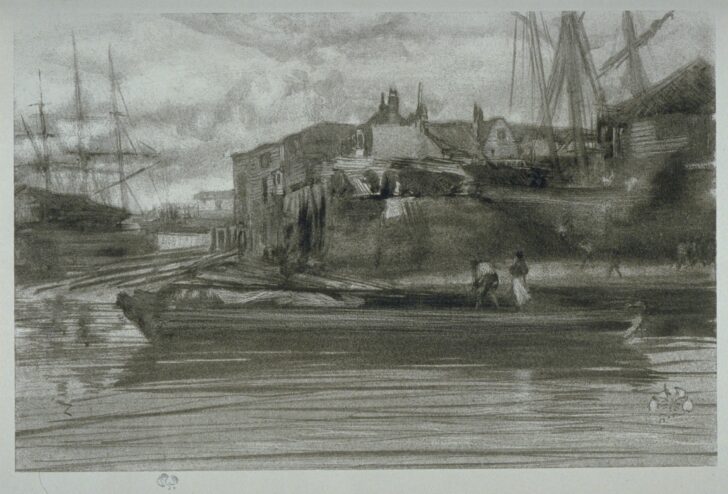Limehouse
James Abbott McNeill Whistler

Description
Limehouse
1878
Lithotint with scraping and incising, on a prepared half-tint
ground
Second state of three (Way 4; Chicago 7)
Bequest of Margaret Watson Parker, 1954/1.412
Whistler eventually settled in the Chelsea region of London, which had extensive views of the Thames; it was from a barge on the river that Limehouse was drawn. The printer Thomas Way (1837–1915), who was aware of developments in art lithography in France and foresaw a market for it in England, was keen to recruit artists to work in the medium; Way arranged for Whistler to draw on limestone blocks and had them transported to the sites where he wanted to work—he even sat beside him as he produced this lithotint.
Whistler experimented with all aspects of the lithographic process to achieve the results he desired. In creating this image, he employed a half-tint tonality to create an overall middle value, and then he scraped through this layer to produce highlights; over this half-tint area he layered additional lines to create darker areas and included tusche to emulate ink wash drawings. This is one of only about thirty-five impressions taken of the second state,
after these changes had been made.
Subject Matter:
The London lithographic printer Thomas Way introduced Whistler to lithography; this is Whistler's first lithograph, drawn on stone from a boat that Way provided the artist. Whistler was becoming acquainted with the potentials of this new medium and discovered that the image was printing too dark and needed to lighten the overall image by scraping away some of what he had drawn.
Physical Description:
Seen from the water, which dominates the foreground, a barge with a standing man and woman occupy the middle distance. Beyond to the left a three-masted ship is in dry-dock, separated from other buildings and activities on the right by a small inlet of water. Behind the barge to the right is a complex of clapboard buildings; at the far right is another sailing ship pulled out of water. A group of men with flaming torches are tarring the exterior of the hull. This is a view of a busy dockyard along the river Thames under a blustery, cloudy sky.
Usage Rights:
If you are interested in using an image for a publication, please visit https://umma.umich.edu/request-image/ for more information and to fill out the online Image Rights and Reproductions Request Form.